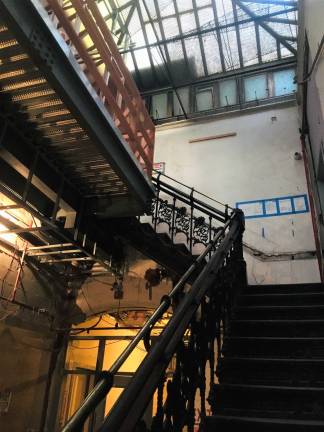The Chelsea Hotel: A never-ending story

In its storied 136-year life, the Chelsea Hotel has reinvented itself several times — as an experimental housing cooperative, an elegant hotel, and most famously, a bohemian enclave of long-term residents and transient guests. In 2011, an entirely new chapter began in its life story: as a semi-permanent construction zone.
Eight years into a major renovation, the building’s conversion to a luxury hotel and apartments is far from complete. During this same period, the six glass and steel skyscrapers in Hudson Yards were built from the ground up.
In early 2018, Ira Drukier, co-owner of the hotel with Richard Born, said they hoped to have the upper floors of the building in operation by the end of 2018. But a year later, the hotel appears unlikely to reopen by the end of 2019, according to a hotel employee, who asked not to be named.
Although much of the interior work, including the elevators, could be finished by November, the employee said, work on the electrical and plumbing systems will almost certainly continue into 2020.
A partial stop-work order in place since November 2018 and a pending tenant lawsuit filed in January 2019 have the potential to further derail the schedule.
According to the employee, the hotel lobby, main entrance, and a new cellar bar could still be ready to open to the public by the end of the year. Less certain is a reopening date for the first-floor restaurant, El Quijote, which closed in March 2018 for a six-month renovation, a project now entering its 16th month.
Lawyers, Snafus and MoneyThe causes of the delays have been well-documented in the news, on the internet and in social media. They include three different sets of owners since 2011, a revolving cast of contractors and architects, construction snafus, tenant conflicts, regular 311 complaints, stop-work orders from the city, multiple lawsuits and many millions of dollars spent.
When the long-time owners sold the hotel in 2011, the 12-story building’s elevators and electrical, plumbing and ventilation systems needed a complete overhaul, work made trickier by the age of the building.
The more significant challenge, however, were the 80 or so long-term residents, some under rent protection, who didn’t want to leave. While contractors have been forced to take extra care to not adversely affect the tenants, eight years of constant noise, elevator breakdowns, and unpredictable utility shut-offs have taken a toll. Only around 50 hardy souls remain.
“Hell on Earth” These days, residents must pass through protective plastic sheeting to enter or leave their apartments. Corridors have unfinished walls, floors, and ceilings, and only one working elevator serves the building.
Rita Barros lives on the 10th floor, where a persistent roof leak wreaks havoc on her apartment and the hotel corridor with every hard rain. She and her neighbors have lived with the leak for going on eight years.
“It is a tragic story for those of us who still live there.” Barros said in an email. “It’s been hell on earth. The drilling, dust, lack of services, continuous floods, etc etc.”
In late 2011, environmental testing revealed toxic levels of lead and asbestos in the construction dust. More testing in 2017 found lead levels well above the acceptable limit.
Pamela Wolff, who serves on Community Board 4’s Land Use committee, has lived in the Chelsea neighborhood most of her life. Her mother even lived in the Chelsea Hotel for a time, she said. She worries about the fate of the historic interiors of the hotel, such as the 1880s-era ceiling murals that decorate the men’s smoking lounge and ladies’ ‘parlor’ on the ground floor.
In an early meeting with the current owners, Wolff said “I begged them at the time to be sure and preserve everything they possibly could. And they said that was their intention.”
The building management did not respond to requests for updates. The hotel employee confirmed the intention to preserve these special elements, but could not provide their actual status.
Positive Signs of Progress Wolff hopes the current owners will finally bring the project to a close, above all for the sake of the residents. “If [the owners] go broke, they’re going to sell at a bargain price to some other developer and there they go again. And there all those tenants go again with the same battles all over again. That’s why I’m hoping they don’t [sell], that the tenants and their problems, that are very real and very desperate, don’t break the backs of these owners.” Wolff said. “It would be really bad if they went bankrupt or just bailed.”
Positive signs of progress are finally starting to appear. The sidewalk bridge on West 23rd Street is still in place, but the scaffolding and black mesh that covered the building’s striking red-brick façade for several years finally came down a few months ago.
Wolff said she likes what she sees so far. “From my preservationist’s eye, the whole street-facing façade is now quite lovely, as it always has been. They didn’t muck it up. They didn’t trash it with terrible windows. They kept the stained glass,” she said. “Preservation-wise, at least on the exterior, it makes my heart warm to see that they’ve done that job.”